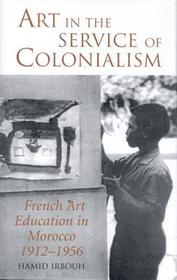
Art in the Service of Colonialism
French Art Education in Morocco 1912-1956
Sorozatcím: International Library of Colonial History;
-
20% KEDVEZMÉNY?
- A kedvezmény csak az 'Értesítés a kedvenc témákról' hírlevelünk címzettjeinek rendeléseire érvényes.
- Kiadói listaár GBP 130.00
-
62 107 Ft (59 150 Ft + 5% áfa)
Az ár azért becsült, mert a rendelés pillanatában nem lehet pontosan tudni, hogy a beérkezéskor milyen lesz a forint árfolyama az adott termék eredeti devizájához képest. Ha a forint romlana, kissé többet, ha javulna, kissé kevesebbet kell majd fizetnie.
- Kedvezmény(ek) 20% (cc. 12 421 Ft off)
- Kedvezményes ár 49 686 Ft (47 320 Ft + 5% áfa)
Iratkozzon fel most és részesüljön kedvezőbb árainkból!
Feliratkozom
62 107 Ft

Beszerezhetőség
Megrendelésre a kiadó utánnyomja a könyvet. Rendelhető, de a szokásosnál kicsit lassabban érkezik meg.
Why don't you give exact delivery time?
A beszerzés időigényét az eddigi tapasztalatokra alapozva adjuk meg. Azért becsült, mert a terméket külföldről hozzuk be, így a kiadó kiszolgálásának pillanatnyi gyorsaságától is függ. A megadottnál gyorsabb és lassabb szállítás is elképzelhető, de mindent megteszünk, hogy Ön a lehető leghamarabb jusson hozzá a termékhez.
A termék adatai:
- Kiadó I.B. Tauris
- Megjelenés dátuma 2005. július 27.
- Kötetek száma Hardback
- ISBN 9781850438519
- Kötéstípus Keménykötés
- Terjedelem296 oldal
- Méret 216x138 mm
- Súly 494 g
- Nyelv angol
- Illusztrációk 40 black and white illustrations 0
Kategóriák
Hosszú leírás:
"Art in the Service of Colonialism" throws new light on how nothing in the Moroccan French Protectorate (1912-1956) escaped the imprints of metropolitan ideology and how the French transformed and dominated Moroccan society by looking at how the arts and crafts were transformed in the colonial period. Hamid Irbouh argues that during the Moroccan Protectorate (1912-1956), the French imposed their domination through a systematic modernisation and regulation of local arts and crafts. They also stewarded Moroccans into industrial life by establishing vocational and fine arts schools. The French archives, Arabic sources, and oral testimonies, which Irbouh used, demonstrate complex relationships between colonial administrators of both genders and their interactions with Moroccan officials, notables, and the poor. The French co-opted some locals into joining these educational institutions, which respected and reinforced familiar pre-Protectorate social structures. The artisans become The Best Workers in the French Empire, and artists exhibited abroad and cultivated a European and American clientele.
The contradictions between reformist goals and the old order, nevertheless, added to social dislocations and led to rebellion against French hegemony. Irbouh focuses on how French women infiltrated the feminine Moroccan milieu to buttress colonial ideology, and how, at critical moments, Moroccan women and their daughters rejected traditional passive roles and sabotaged colonial plans. France's legacy in Moroccan arts and crafts provoked a backlash in the postcolonial period. After independence local artists, searching for their own identities, sought to reclaim their authenticity. The struggle to define a pristine visual heritage still rages, and the author, by underlining French contributions to Moroccan artistic and craft production, challenges the conclusions of the artists and critics who have argued for the establishment of an unadulterated art devoid of most or even all foreign influences. As in so many areas of Moroccan society, this book reveals that the weight of colonial history remains heavily present.
In this well-conceived book based on original archival sources Hamid Irbouh investigates how French colonial administrators employed French women to inculcate colonial ideology by establishing new craft schools for notable and poor families in Moroccan cities. The French intended not only to teach modernized versions of old Moroccan crafts, but also wanted to instill new work habits and modern concepts of time into the girls and young women who attended their schools. Dr. Irbouh demonstrates how French women administrators took the lead in this effort and also shows how Moroccan women absorbed their lessons, but also resisted the colonial enterprise. His is a novel approach to colonial art history, situating Moroccan art production in large social, political and ideological contexts.
Tartalomjegyzék:
Archive Centres and Libraries Mentioned in the Text
List of Illustrations
Acnowledgements
Introduction
The Establishment of French Colonial Hegemony over Morocco
Contemporary Moroccan Scholarship on Moroccan Art Production
French Colonial Art Education in Morocco
Book Outline
Part One: Classifications and Associations
Chapter One : Framing Morocco's Crafts
Chapter Two: Diffusing Colonial Order
Part Two: Design and Process of Colonial Education
Chapter Three: Colonial Mass Education
Chapter Four: Vocational Schools for Men and the French Infiltration of Morocco's Traditional Industry
Chapter Five: Women's Vocational Schools
Part Three: Originality, Drawing and Colonial Exploitation
Chapter Six: Vocational Training and Patriotism in France
Chapter Seven: Drawing as an Apparatus of Exploitation
Chapter Eight: The Open Workshops and the Casablanca School of Fine Arts
By Way of Conclusion: The Burden of Cultural Decolonisation
The Populists
The Nativists
The Bipictorialists
Notes
Bibliography
Index




